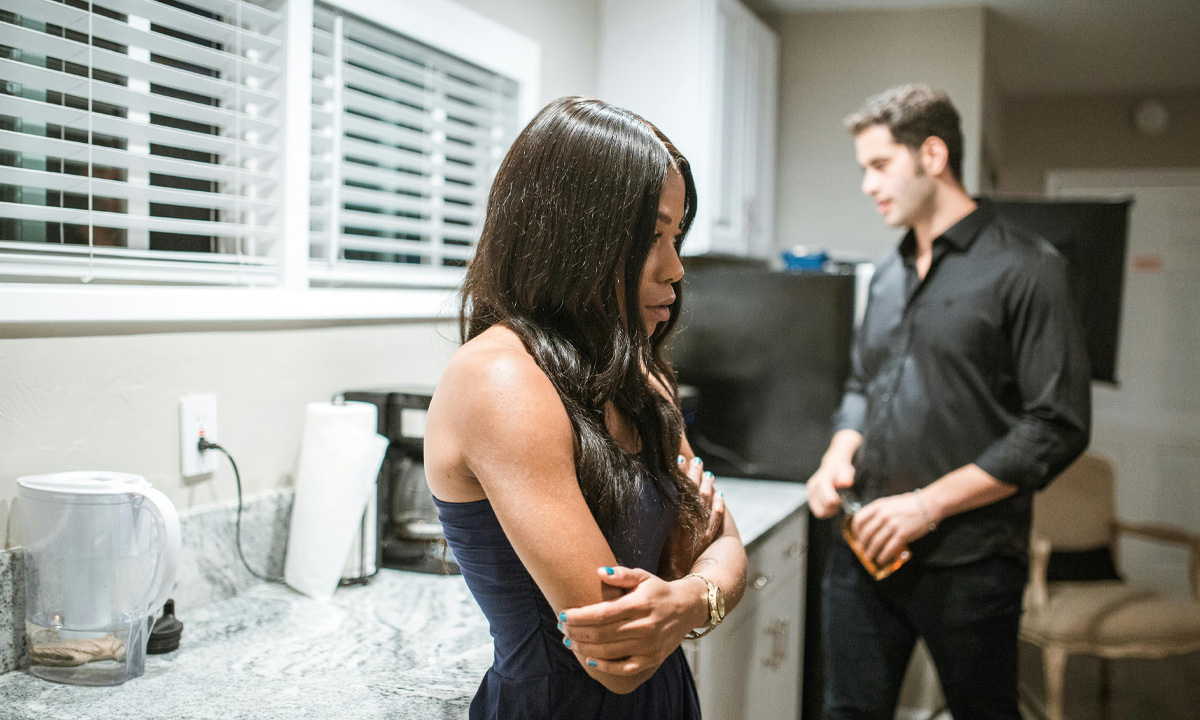Lifestyle
Should I Break Up With My Partner Over Their Drinking?
Alcoholism is an increasingly prominent part of life at the moment, with more people finding themselves suffering or entering rehab than ever…

Alcoholism is an increasingly prominent part of life at the moment, with more people finding themselves suffering or entering rehab than ever before.
The likes of NHS rehab clinics are being overun with patients, but it can be a long journey to even get to that point and many people don’t even realise they have a problem with drinking. Which is problematic not only for them, but partners too.
A partner’s drinking habits can have a huge impact on a relationship and in many cases, the other half will consider breaking up, running away, or sticking around and ensuring they take the right course of action.
There’s no right or wrong answer in such cases, and it is a personal decision that involves many different factors. If this is the situation you find yourself in, here’s what you should consider.
Recognising Problem Drinking
The first step is to recognise that your partner does have a problem with drinking in the first place and the effect it’s having on them. There are many warning signs that a partner is drinking too much, including…
- ● Frequent heavy drinking: If your partner often drinks to the point of drunkenness or relies on alcohol to get through daily activities, this could indicate a problem.
- ● Mood swings or aggression: Alcohol can cause changes in mood, and if your partner becomes irritable, angry, or aggressive when drinking, this is a red flag.
- ● Neglecting responsibilities: If your partner is frequently missing work, avoiding social obligations, or neglecting important tasks due to drinking, it’s a sign that alcohol is taking priority.
- ● Health issues: Physical signs such as frequent hangovers, weight gain, or health problems linked to alcohol consumption can signal problematic drinking.
- ● Denial or secrecy: If your partner hides their drinking, becomes defensive when asked about it, or denies how much they are consuming, this could suggest that they are aware of their problem but are unwilling or unable to address it.
Impact on the Relationship
If you’ve recognised that their drinking is becoming an issue, the next important step is to understand exactly how it’s affecting your relationship. Problem drinking can have a big impact on many different aspects of a relationship, often causing arguments and distress, as well as a number of other issues. You should think about…
- ● Emotional distance: Alcohol can create a barrier between you and your partner, leading to feelings of isolation or emotional neglect.
- ● Financial strain: Excessive drinking can result in financial problems, especially if your partner is spending large amounts of money on alcohol.
- ● Resentment: If you find yourself taking on more responsibilities or constantly covering for your partner’s behaviour, you may begin to feel resentful. Over time, this resentment can damage your relationship beyond repair.
- ● Lack of trust: Problem drinking can lead to broken promises, dishonesty, and secrecy, which can undermine the trust and security that are vital to a healthy relationship.
Communicating Your Concerns
If it is the case that your partner’s drinking is having a significant impact on your relationship, you should have a conversation with them and communicate your concerns. It’s a tricky conversation to have, but it’s so important to let them know how their drinking is affecting the relationship, as it’s likely they may not even be aware.
You should focus on how their behaviour makes you feel and the changes you see in them, as well as the relationship. Discuss your worries and the future of the relationship, while you should ensure that it is an open conversation with your partner able to express their feelings too. It may be that they are struggling to cope with certain stresses, anxieties or depression that is leading them to drinking in the first place, of which they may be cooperative in getting help.
Seeking Help
Help is an important port of call. If your partner is open to addressing their drinking then it may be that you want to remain in the relationship and support them. There are tons of resources available to help them, from going to rehab, speaking to doctors, seeing counsellors and attending support groups.
You can’t force your partner into change, it needs to come off their own back and they must be willing to take responsibility or it might be the time to exit the relationship.
Deciding Whether to Stay or Go
Ultimately, whether you stay in the relationship or not is a decision that only you can make. If your partner acknowledges their problem and is willing to seek help, it may be worth giving the relationship a chance. Recovery from alcohol addiction is possible, but it requires time, effort, and commitment from both partners.
However, if your partner refuses to address their drinking or if their behaviour continues to have a detrimental impact on your well-being, it may be time to consider ending the relationship. Staying in a relationship where addiction is present can be emotionally draining and harmful, and you must prioritise your own mental and emotional health.
Lifestyle
YouTuber Dashie Reflects on His Inspirational Weight Loss Journey
Charlie Guzman, best known as Dashie, is an American YouTuber whose comedy videos and gaming commentary videos have earned him over 5 million…


Charlie Guzman, best known as Dashie, is an American YouTuber whose comedy videos and gaming commentary videos have earned him over 5 million subscribers on his DashieGames channel.
He is best known for his hyperactive, loud, and funny commentary on games like Happy Wheels, Mortal Kombat, and Grand Theft Auto. He has worked on videos with other YouTubers like Jesse Wellens, T-Pindell, and the famous rapper Logic.
Dashie is also a talented musician who released 3022(UnOfficialMixtape) in October 2019.
The internet star further gained popularity when he shed 50 pounds of weight back in 2021. How did he do that? Have a look!
Dashie decided to lose weight for health reasons
In an interview with Tim Chantarangsu, the YouTuber revealed that his weight loss journey began when his doctor informed him that he had fat tissues growing into his liver.
Dashie did not like that sound and immediately thought of taking action. He mentioned that after he returned from the doctor, he threw all foods that were bad for his health from his fridge.
When the host brought up that Dashie was intermittent fasting, Dashie said, “so listen i have been on a diet for life 10 years.”
But he also shared that after losing a significant amount of weight, he got comfortable and started indulging, which led to extra weight gain.
The YouTuber mentioned, “The problem with me is, I lose like a good 20 pounds, I get comfortable again. I am like, ‘I look good’ and start eating bad again.”
“You get comfortable, and you kinda forget about it, then before you know, you gain back that 20 plus 10,” he shared his weight problem in the show.
He said that his ultimate weight loss journey began with a doctor-scare that got him thinking that he really has to lose some weight.
He has also uploaded a video on his YouTube channel where he explained how he lost 50 pounds of weight while playing a game after he got a lot of question about how he did it. The video is titled ‘HOW I LOST 50 POUNDS!’
Dashie later took to Instagram to let his fans know he has shared his experience by posting his transformed photo. The caption read, “About a week ago, I posted a video where I shared my routine and what I’ve been doing to lose weight/maintain.”
“I’ve gotten so many comments and messages about how much I’ve inspired people to do the same! That makes me so happy!”
He continued, “And also inspires me to keep going! I’ll be honest maintaining is NOT easy! But I figured if I post things like this every now and then, y’all can yell at me if I ever slip back! Lol, Thank you! And I’m here to support y’all too!!”
Dashie mentioned in one of his videos that he has ADHD
Dashie was born in the Dominican Republic and raised there until he was eight, when his family relocated to Florida. His Spanish skills helped him get his first job after graduating high school, according to Healthy Celeb.
He started working as a grocery store manager after changing jobs several times, including one at a Subway restaurant. In March 2006, while working there, he began posting YouTube videos.
He has shared in his videos that he has ADHD (Attention Deficit Hyperactivity Disorder). He also frequently advises young subscribers on his channel to avoid alcohol and drugs.
Lifestyle
What Do Women Like in a Man?
Understanding what women find attractive in a man can be a complex topic. It’s important to remember that each woman’s preferences will differ,…

Understanding what women find attractive in a man can be a complex topic. It’s important to remember that each woman’s preferences will differ, but there are some key attributes that many women value in a partner.
This article will delve into these characteristics, providing insights into what many women seek in a romantic partner.
Confidence That Doesn’t Cross the Line
One of the most attractive qualities to many women is a man who exudes confidence. A self-assured man is often seen as someone who knows his worth and isn’t afraid to show it. However, it’s essential to differentiate between healthy confidence and arrogance.
While a confident man is comfortable in his skin, an arrogant man may come across as self-absorbed or overly aggressive. A balance of humility and self-assurance is key to appealing to many women.
Emotional Intelligence: A Key Ingredient
In recent years, emotional intelligence (EI) has gained increasing attention as a crucial factor in successful relationships. Women often appreciate men who can empathize, understand their emotions, and communicate effectively.
A man with high emotional intelligence is more likely to be supportive, understanding, and emotionally available. Additionally, men who can express their feelings and navigate difficult conversations are often seen as strong and dependable partners.
A Touch of Chivalry
While modern society has made strides in gender equality, many women still appreciate chivalry. This doesn’t mean that men should adhere to outdated gender roles, but rather that small acts of kindness and respect can go a long way.
Holding the door open, offering a helping hand, or simply being polite and attentive can make a woman feel valued and cherished.
Authenticity: The Foundation of Trust
A man who is genuine and authentic is often highly attractive to women. In a world where social media can create a facade of perfection, authenticity is a breath of fresh air. Women often seek partners who are true to themselves, with a clear sense of identity and values.
This means being honest about one’s feelings, intentions, and desires without trying to be someone they’re not. Authenticity fosters trust and creates a solid foundation for a lasting relationship.
A Good Listener and Communicator
Listening and communication skills are essential in any relationship, and many women find these traits particularly attractive in a man.
A man who actively listens, asks questions and shows genuine interest in a woman’s thoughts and feelings demonstrates that he values her perspective. Good communication skills also entail being able to express one’s thoughts and feelings clearly and respectfully.
Shared Interests and Complementary Lifestyles
A strong relationship often relies on shared interests and lifestyles. While it’s not necessary for couples to have identical hobbies, having common ground can provide opportunities for bonding and create a sense of camaraderie.
Women might seek out men who share their passion for certain activities or who have complementary lifestyles, as this can facilitate a strong connection and a sense of unity within the relationship.
Ambition and Drive
Many women are attracted to men who are ambitious and driven. This doesn’t necessarily mean that they need to be a successful sugar daddy or be wealthy, but rather that they have clear goals and are motivated to achieve them.
A man with ambition and drive can be inspiring and demonstrate that he is committed to personal growth and self-improvement.
A Sense of Humor: Laughter is the Best Medicine
A sense of humor can be an irresistible trait for many women. Men who can make their partners laugh, whether through witty banter or self-deprecating humor, often create an enjoyable and relaxed atmosphere. Laughter can foster a strong emotional connection, as it demonstrates a shared sense of humor and helps couples navigate difficult times with levity.
Physical Attraction: The Cherry on Top
While physical attraction shouldn’t be the sole basis of a relationship, it’s undeniable that it plays a role in what women find appealing in a man. Physical attraction can vary significantly between individuals, and what one woman finds attractive might not be the same for another.
However, taking care of one’s appearance, dressing well, and maintaining personal hygiene can increase a man’s attractiveness in the eyes of many women.
Emotional Stability: A Pillar of Strength
Emotional stability is another characteristic that many women find attractive in a man. A man who is emotionally stable can provide a sense of security and support during challenging times. This doesn’t mean that men should suppress their emotions, but rather that they should be able to manage their feelings in a healthy and constructive manner. Emotional stability also encompasses the ability to remain calm and level-headed during stressful situations.
Resilience: Overcoming Life’s Challenges
Life is full of obstacles and challenges, and a resilient man is often attractive to women. Resilience means the ability to bounce back from setbacks and maintain a positive outlook on life.
A resilient man demonstrates that he can cope with adversity, learn from experiences, and grow stronger in the process. This quality can provide a sense of comfort and assurance to a woman, knowing that her partner will be able to navigate life’s ups and downs.
In conclusion, while individual preferences may vary, there are several key attributes that many women find attractive in a man. Confidence, emotional intelligence, authenticity, and a sense of humor are just a few of the characteristics that can make a man appealing to women.
By developing these qualities and striving for personal growth, men can increase their attractiveness and foster strong, lasting relationships.
Lifestyle
Tuner Lifestyle: Elevating the Car Enthusiast Experience
Tuner Lifestyle is more than just a brand, it’s a destination for car enthusiasts who want to celebrate their love for cars in style.Born from a…

Tuner Lifestyle is more than just a brand, it’s a destination for car enthusiasts who want to celebrate their love for cars in style.
Born from a small social media community in 2017, Tuner Lifestyle has since grown into a leading provider of high-quality merchandise for car enthusiasts everywhere.
With over 500,000 followers on Instagram and Facebook, Tuner Lifestyle has established itself as a go-to source for all things car-related.
-

 Exclusive2 weeks ago
Exclusive2 weeks agoKay and Tay Dudley Family Update 2026: Meet Baby Sutton Blair and Big Sister Ellie
-

 Entertainment2 weeks ago
Entertainment2 weeks agoPurple Hearts 2 Update 2026: Release Date Rumors and Sofia Carson News
-

 Exclusive2 weeks ago
Exclusive2 weeks agoKylie Jenner and Timothee Chalamet Move In After Three Years of Dating
-

 Actress3 weeks ago
Actress3 weeks agoElla Purnell: Exploring the Actress’s Career, Dating Life, and Personal Growth
-

 News2 weeks ago
News2 weeks ago‘Breaking Amish’ Star Jeremiah Raber Airlifted to Hospital With Possible Liver Failure
-

 Celebrity2 weeks ago
Celebrity2 weeks agoBristol Palin Reveals New Treatment Plan for Facial Paralysis During Grim New Year Update
-

 News2 weeks ago
News2 weeks agoHugh Jackman and Bikini-Clad Girlfriend Sutton Foster Pack on the PDA in Costa Rica
-

 Celebrity3 weeks ago
Celebrity3 weeks agoTruth About Ryeowook Wedding, Wife, and Gay Rumors
